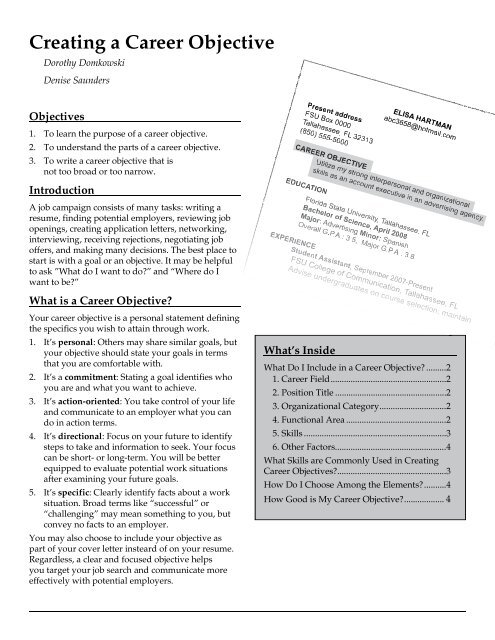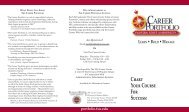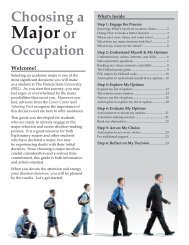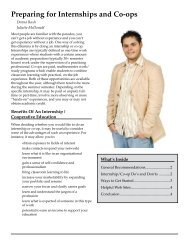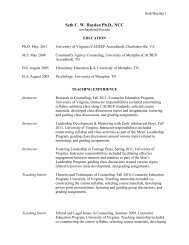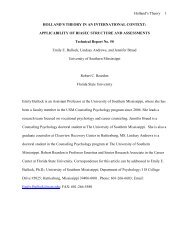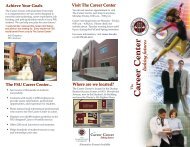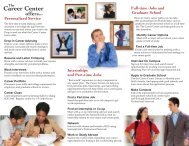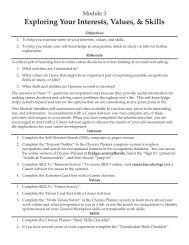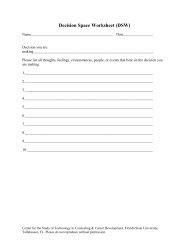Creating a Career Objective - The Career Center
Creating a Career Objective - The Career Center
Creating a Career Objective - The Career Center
Create successful ePaper yourself
Turn your PDF publications into a flip-book with our unique Google optimized e-Paper software.
<strong>Creating</strong> a <strong>Career</strong> <strong>Objective</strong>Dorothy DomkowskiDenise Saunders<strong>Objective</strong>s1.2.3.To learn the purpose of a career objective.To understand the parts of a career objective.To write a career objective that isnot too broad or too narrow.IntroductionA job campaign consists of many tasks: writing aresume, finding potential employers, reviewing jobopenings, creating application letters, networking,interviewing, receiving rejections, negotiating joboffers, and making many decisions. <strong>The</strong> best place tostart is with a goal or an objective. It may be helpfulto ask ”What do I want to do?” and “Where do Iwant to be?”What is a <strong>Career</strong> <strong>Objective</strong>?Your career objective is a personal statement definingthe specifics you wish to attain through work.1. It’s personal: Others may share similar goals, butyour objective should state your goals in termsthat you are comfortable with.2. It’s a commitment: Stating a goal identifies whoyou are and what you want to achieve.3. It’s action-oriented: You take control of your lifeand communicate to an employer what you cando in action terms.4. It’s directional: Focus on your future to identifysteps to take and information to seek. Your focuscan be short- or long-term. You will be betterequipped to evaluate potential work situationsafter examining your future goals.5. It’s specific: Clearly identify facts about a worksituation. Broad terms like “successful” or“challenging” may mean something to you, butconvey no facts to an employer.You may also choose to include your objective aspart of your cover letter insteard of on your resume.Regardless, a clear and focused objective helpsyou target your job search and communicate moreeffectively with potential employers.What’s InsideWhat Do I Include in a <strong>Career</strong> <strong>Objective</strong>? .........21. <strong>Career</strong> Field....................................................22. Position Title ..................................................23. Organizational Category..............................24. Functional Area .............................................25. Skills ................................................................36. Other Factors..................................................4What Skills are Commonly Used in <strong>Creating</strong><strong>Career</strong> <strong>Objective</strong>s?.................................................3How Do I Choose Among the Elements?..........4How Good is My <strong>Career</strong> <strong>Objective</strong>?.................. 4
What Do I Include in a <strong>Career</strong> <strong>Objective</strong>?Deciding what to include in a career objective can be difficult. <strong>The</strong> following pages specify ten elements youcan include in your objective. Remember, the elements you choose should align with your personal situation.1. <strong>Career</strong> Field<strong>Career</strong> fields are general areas of work which includemany different job titles that require similar kinds ofwork activities.You may be considering several different job titleswithin a career field. Identifying the career fieldcategory allows you to specify a broad area you areinterested in without limiting yourself to specifictitles. While you may be interested in more than onecareer field, for purposes of the career objective, it isbetter to limit yourself to one.Examples:“To work in the health field as an administrator in aservice delivery unit.”“To do research within the field of law.”2. Position TitlePosition title, occupational title, or job title is thename of a specific position one holds. While someorganizations may have their own reference names,most position titles are generic and generalizable tomany organizations.Listing a position title on your career objectiveis appropriate if you know you will be applyingfor a specific position either in many differentorganizations or one targeted organization.Examples:"To obtain a position of accountant with a public accountingfirm and eventually become a partner.”“To act as a community organizer where I can usemy human relations, administrative, and researchskills.”3. Organizational CategoryOrganizational category refers to settings in whichyou might like to work. In the broadest sense,organizations are categorized as either serviceproducingor goods-producing. More specifically,organizations are categorized by industry groups.One or more of these groups may appeal to you.Identifying a category or industry group helpsyou identify specific employers within that group.In your objective, you narrow your focus anddemonstrate interest in a specific setting withoutnaming individual employers.Examples:“To work within the telecommunications industry as atechnical advisor.”“To secure a position as an editor for a mid-size publishingfirm.”4. Functional AreaFunctional area refers to the structure of anorganization. Most organizations are differentiatedinto various departments, each responsible forcompletion of specific tasks or functions. <strong>The</strong> largerthe organization, the more differentiated it usuallyis, that is, the more specific the functions. Smallerorganizations may have the same departmenthandling several functions.Identifying a functional area in a career objectivespecifies which part of the organization would beof interest to you without narrowing yourself to aspecific industry group or organizational category.Examples:“To work in the government relations function within aFortune 500 organization.”“To obtain a management trainee position within thequality control unit of a production department.”2<strong>Creating</strong> a <strong>Career</strong> <strong>Objective</strong>
5. SkillsSkills are special talents, functions, (General Skills)or tasks (Specific Skills) that you have learned todo well. <strong>The</strong>y are behaviors you exhibit and aremost likely developed through academic, work, andleisure experiences. Some of these same skills mightbe used in one occupation or transferred to severaldifferent occupations (i.e., transferable skills).Skills involve knowledge and physical behaviorsallowing you to not be limited to a specific careerfield or organizational category. Most jobs require acombination of skills. Identifying your combinationlets the employer know where you might fit into theorganization.5a. General skillsGeneral skills are broad areas which encompassrelated specific skills. Identifying general skills in anobjective identifies the combination of skill areas youprefer to use in your work.Examples:“To use my scientific and human relations skills as aNursing Supervisor.“To work for a government agency using my managementand communication skills.”General skill areas you may want to use include:administrativeartisticathleticclerical5b. Specific Skillscommunicationscreativehuman relationsmanagementmathematicalmechanicalscientifictechnicalSpecific skills are specific actions or behaviorsused to perform tasks. Identifying specific skills inyour career objective allows you to highlight yourstrengths or specializations within a general skillarea.Examples:“To use my artistic skills especially doing layout,graphic design, and lettering for an advertising firm.”“To work for a rehabilitation agency and use my groupand individual counseling skills.”View the included list to find skills that arecommonly used in career objectives. You may alsowant to consider your own specific skills in order toidentify skills you wish to use in your objective.What Skills are Commonly Used in<strong>Creating</strong> <strong>Career</strong> <strong>Objective</strong>s?accountactadministeradvertiseadviseanalyzeappraisearrangeassembleassistauditbudgetbuildcalculatecataloguechartclarifycollectcommunicatecompetecompletecompilecomposeconductcontrolcoordinatecorrectcounselcreatedancedelegatedemonstratedecidedesigndeterminedevelopdiagnosedirectdocumentdraftdraweditengineerentertainestablishevaluateexerciseexhibitexperimentfacilitateformulatefurnishguidehireimplementimproveinitiateinfluenceinspectinstallinstructinterpretinterviewinvestigatejudgelandscapeleadmakemanagemarketmeetmobilizemodelmotivatenegotiateoperateorderorganizeoriginateperformpersuadephotographplanplaypredictpreparepresentproduceprogrampromoteproposeprovidepublishpurchasequalifyraisereadrecommendrecruitrepairreportresearchscheduleselectsellservesolvestaffstartsupervisesynthesizeteachtesttraintranslatetraveltutortypeverifywrite<strong>Creating</strong> a <strong>Career</strong> <strong>Objective</strong> 3
6. Other Factors<strong>The</strong>re are other factors you can place in your careerobjective. <strong>The</strong>se include any limits, conditions, orpersonal criteria which would affect your worksituation and are important to identify.By identifying other factors, you can further focusyour goals and communicate them to employers.However, you may wish to limit the extent you focuson these types of factors in your career objective.Being too narrowly focused may cause you tooverlook potentially satisfying employment options.Examples:“To work outdoors in a supervisory capacity for theUnited States Forest Service.”“To obtain a secondary teaching position in the southeastUnited States.”“To work in law enforcement and pursue additionalspecialized training in forensics.”Other factors regarding your own limits, conditions,or personal criteria for employment might include:6a. PopulationsPopulations are the people you work with as you doyour work. <strong>The</strong>y could be your peer group at work(i.e., your colleagues). However, in a career objective,population usually refers to the clients or customersof your services or products.Examples:“To work with elderly individuals in the field ofrecreational therapy.”“To design programs for children with disabilities.”6b. GoalsShort-term goals are those goals you wish to achieveimmediately. Identifying short-term goals helps youfocus where to begin your professional career. Also,they help you identify next steps in your job search.Examples:“To obtain an entry level position of Weather Observer.”Long-term goals are those goals you wish to achievein 5 to 10 years. Having long-term goals can bebeneficial to you in two main ways:1.2.Many organizations have staffing plans regardingwhere they want their employees to be in theorganization in the future. By having your plan,you and the employer can evaluate if there isa match with respect to where you may start,advance, and finish in a given time period.Our society is constantly changing and likewise,jobs change. No doubt, as you’re working,opportunities and problems will occur. Longtermgoals give you a yardstick to evaluate thesituation and make decisions.Example:“To begin employment in a beverage managementposition which provides opportunities for advancementto a top, policy-making position in the organization.”How Do I Choose Among the Elements?As you review the information included in the <strong>Career</strong><strong>Objective</strong> Guide, think about which elements youwish to include in your own career objective. Keep inmind, elements that may be useful in other job searchactivities such as interviewing or negotiating offers.For your written career objective, choose at least oneelement but no more than three or your objectivemay be too lengthy. You may want to have differentcareer objectives for different work situations orenvironments that you are considering.How Good is My <strong>Career</strong> <strong>Objective</strong>?<strong>Career</strong> objectives can be:• Personal• Commitment‐oriented• Action‐oriented• Directional• SpecificBrainstorm possible elements of your careerobjective. If you have difficulty writing yourobjective, drop-in to the <strong>Career</strong> <strong>Center</strong> and ask acareer advisor for help getting your future careergoals on paper.850.644.6431 • career.fsu.eduAlternative format available.Revised 5/09. Pub ID: 34.


